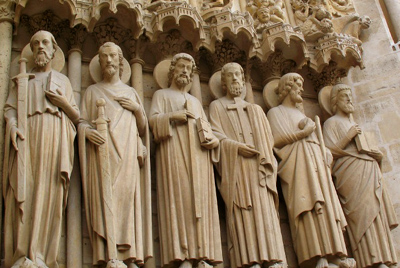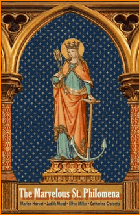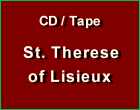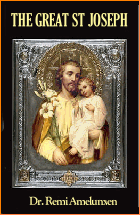Symbolism
 |
 |
 |
 |
 |
 |
 |
What the Emblems of the Apostles Represent
It is evident to those who know Chartres, Amiens or Notre Dame at Paris that the Middle Ages placed the Apostles in the forefront of the host of saints to whom they paid homage. For they are placed on either side of the principal doorway, and they surround the figure of Christ. They are painted or carved two or three times in all the cathedrals, and we too must give them a place of honor.
It was in large measure due to art that every circumstance in the lives of the chief Apostles were known to the faithful. It was generally said that each had evangelised a different country. St. Peter brought the faith to Rome, St. Paul carried it from Jerusalem to Illyria, St. Andrew made it known to Achaia, St. James the Great to Spain, St. John to Asia, St. Thomas to India, St. James the Lesser to Jerusalem, St. Matthew to Macedonia, St. Philip to Galatia, St. Bartholomew to Lycaonia, St. Simon to Egypt and St. Jude to Mesopotamia.
The Apostles & their emblems
 At Chartres St. Peter, St. Paul and St. John are alone recognizable by traditional features. St. Peter has short curly hair and a tonsure, and St. Paul is bald. From primitive times these features of the two chief Apostles have not changed.
At Chartres St. Peter, St. Paul and St. John are alone recognizable by traditional features. St. Peter has short curly hair and a tonsure, and St. Paul is bald. From primitive times these features of the two chief Apostles have not changed.
St. John, the youngest of the Apostles, is represented without a beard, even in extreme old age. The other Apostles are solely recognizable by the attributes they hold in their hands. At first these attributes were given only to several of the Apostles, but as time went on they were given to them all.
Some study of the principal figures of the Apostles found in the churches will indicate the manner in which the artists proceeded.
In Romanesque times the attribute of an Apostle is a book, though St. Peter has the keys in memory of the power given him to bind and to loose. In the 13th century, when the figures of the Apostles were positioned on either side of the porch, it became customary to place in their hands the instrument of their martyrdom.
Agreement as to their manner of death was first reached with regard to the deaths of St. Paul, St. Andrew, St. James the Lesser and St. Bartholomew. St. Paul is given a sword because there was no doubt that he had been decapitated. St. Andrew carries a cross because he was crucified.
St. James the Lesser holds a club because he was beaten to death at the foot of the Temple at Jerusalem by a fuller armed with his stick. And it was generally received that St. Bartholomew had been flayed alive, and a knife was therefore placed in his hand.
Before long three more Apostles received distinctive attributes. As we see in the west porch at Amiens, St. John sometimes carries the poisoned cup which Aristodemus had given him to drink. The strength of the poison was tested on two condemned men, who after they had drunk it fell down dead. But St. John took the cup in the presence of all the people, and after making the sign of the cross, drank the poison yet sustained no hurt. Then, St. John baptized Aristodemus and the governor of the town and all his family.
 St. James, while keeping the sword of martyrdom, has in the other hand a staff like those used by pilgrims to Santiago and his tunic or traveling bag is decorated with the shells brought back from the shore of Galicia, the famous "scallop-shell of St. James." The Apostle is given the appearance of a pilgrim returning from his church at Compostella. By the end of the 14th century, with his staff, his great hat and his cloak decorated with shells, he is the perfect image of the medieval pilgrim.
St. James, while keeping the sword of martyrdom, has in the other hand a staff like those used by pilgrims to Santiago and his tunic or traveling bag is decorated with the shells brought back from the shore of Galicia, the famous "scallop-shell of St. James." The Apostle is given the appearance of a pilgrim returning from his church at Compostella. By the end of the 14th century, with his staff, his great hat and his cloak decorated with shells, he is the perfect image of the medieval pilgrim.
St. Thomas - seen perhaps first in this way on the west façade at Amiens - carries the architect's square in memory of the palace in India that he was charged to build for King Gondoforus.
But one should not think that St. John's cup, St. Thomas's square, the staff of St. James the Greater and even the club of St. James the Lesser were permanent emblems. In fact the only attributes invariable throughout the Middle Ages are those of St. Peter, St. Paul, St. Andrew and St. Bartholomew. The attributes of St. Philip, St. Matthew, St. Simon, St. Jude and St. Matthias were never fixed because their personality was less clear-cut and their legends less definitely known.
It was only during the course of the 15th century that it became imperative to represent St. Philip and St. Jude with a cross, St. Matthew with an axe, St. Simon with a saw, and St. Matthias with a halberd as a sign of the deaths they suffered.
It is rare today to find a complete series of Apostles positioned on a church porch, for many were destroyed in France either during the wars of religion of 1562 or at the time of the Revolution of 1793, but one may safely say that formerly they were ranged on either side of the great doorway of almost every cathedral.

It was in large measure due to art that every circumstance in the lives of the chief Apostles were known to the faithful. It was generally said that each had evangelised a different country. St. Peter brought the faith to Rome, St. Paul carried it from Jerusalem to Illyria, St. Andrew made it known to Achaia, St. James the Great to Spain, St. John to Asia, St. Thomas to India, St. James the Lesser to Jerusalem, St. Matthew to Macedonia, St. Philip to Galatia, St. Bartholomew to Lycaonia, St. Simon to Egypt and St. Jude to Mesopotamia.
The Apostles & their emblems

At Notre Dame, from right to left, St. Peter, St. John, St. Andrew, St. James the Lesser, St. Luke and St. Bartholomew
St. John, the youngest of the Apostles, is represented without a beard, even in extreme old age. The other Apostles are solely recognizable by the attributes they hold in their hands. At first these attributes were given only to several of the Apostles, but as time went on they were given to them all.
Some study of the principal figures of the Apostles found in the churches will indicate the manner in which the artists proceeded.
In Romanesque times the attribute of an Apostle is a book, though St. Peter has the keys in memory of the power given him to bind and to loose. In the 13th century, when the figures of the Apostles were positioned on either side of the porch, it became customary to place in their hands the instrument of their martyrdom.
Agreement as to their manner of death was first reached with regard to the deaths of St. Paul, St. Andrew, St. James the Lesser and St. Bartholomew. St. Paul is given a sword because there was no doubt that he had been decapitated. St. Andrew carries a cross because he was crucified.
St. James the Lesser holds a club because he was beaten to death at the foot of the Temple at Jerusalem by a fuller armed with his stick. And it was generally received that St. Bartholomew had been flayed alive, and a knife was therefore placed in his hand.
Before long three more Apostles received distinctive attributes. As we see in the west porch at Amiens, St. John sometimes carries the poisoned cup which Aristodemus had given him to drink. The strength of the poison was tested on two condemned men, who after they had drunk it fell down dead. But St. John took the cup in the presence of all the people, and after making the sign of the cross, drank the poison yet sustained no hurt. Then, St. John baptized Aristodemus and the governor of the town and all his family.

At Notre Dame, from left to right, St. Paul, St. James the Greater, St. Thomas, St. Philip, St. Jude and St. Matthew
St. Thomas - seen perhaps first in this way on the west façade at Amiens - carries the architect's square in memory of the palace in India that he was charged to build for King Gondoforus.
But one should not think that St. John's cup, St. Thomas's square, the staff of St. James the Greater and even the club of St. James the Lesser were permanent emblems. In fact the only attributes invariable throughout the Middle Ages are those of St. Peter, St. Paul, St. Andrew and St. Bartholomew. The attributes of St. Philip, St. Matthew, St. Simon, St. Jude and St. Matthias were never fixed because their personality was less clear-cut and their legends less definitely known.
It was only during the course of the 15th century that it became imperative to represent St. Philip and St. Jude with a cross, St. Matthew with an axe, St. Simon with a saw, and St. Matthias with a halberd as a sign of the deaths they suffered.
It is rare today to find a complete series of Apostles positioned on a church porch, for many were destroyed in France either during the wars of religion of 1562 or at the time of the Revolution of 1793, but one may safely say that formerly they were ranged on either side of the great doorway of almost every cathedral.

Selected from Emile Mâle,
The Gothic Image: Religious Art in France of the 13th Century.
NY: Harper & Brothers, pp 308-310
Posted September 17, 2014
The Gothic Image: Religious Art in France of the 13th Century.
NY: Harper & Brothers, pp 308-310
Posted September 17, 2014
______________________
______________________











